
Livorno is a port city on the Ligurian Sea on the western coast of the Tuscany region, Italy. It is the capital of the Province of Livorno, having a population of 158,493 residents in December 2017. It is traditionally known in English as Leghorn.
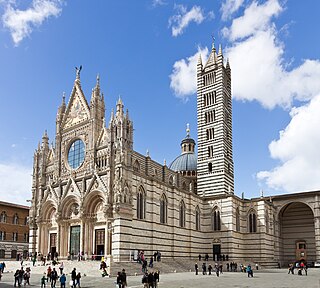
Siena Cathedral is a medieval church in Siena, Italy, dedicated from its earliest days as a Roman Catholic Marian church, and now dedicated to the Assumption of Mary.

The Chiesa di Santa Maria del Giglio is a church in Venice, Italy.

The Church of the Gesù is the mother church of the Society of Jesus (Jesuits), a Catholic religious order. Officially named Chiesa del Santissimo Nome di Gesù, its façade is "the first truly baroque façade", introducing the baroque style into architecture. The church served as a model for innumerable Jesuit churches all over the world, especially in the central Europe and then in the Portuguese colonies. Its paintings in the nave, crossing, and side chapels became models for Jesuit churches throughout Italy and Europe, as well as those of other orders. The Church of the Gesù is located in the Piazza del Gesù in Rome and is one of the great 17th century preaching churches built by Counter-Reformation orders in the Centro Storico.

The Certosa di Pavia is a monastery complex in Lombardy, Northern Italy, situated near a small village of the same name in the Province of Pavia, 8 km (5.0 mi) north of Pavia. Built from 1396 to 1495, it was once located at the end of the Visconti Park a large hunting park and pleasure ground belonging to the Visconti dukes of Milan, of which today only scattered parts remain. It is one of the largest monasteries in Italy.

Pisa Cathedral, officially the Primatial Metropolitan Cathedral of the Assumption of Mary, is a medieval Catholic cathedral dedicated to the Assumption of the Virgin Mary, in the Piazza dei Miracoli in Pisa, Italy, the oldest of the three structures in the plaza followed by the Pisa Baptistry and the Campanile known as the Leaning Tower of Pisa. The cathedral is a notable example of Romanesque architecture, in particular the style known as Pisan Romanesque. Consecrated in 1118, it is the seat of the Archbishop of Pisa. Construction began in 1063 and was completed in 1092. Additional enlargements and a new facade were built in the 12th century and the roof was replaced after damage from a fire in 1595.
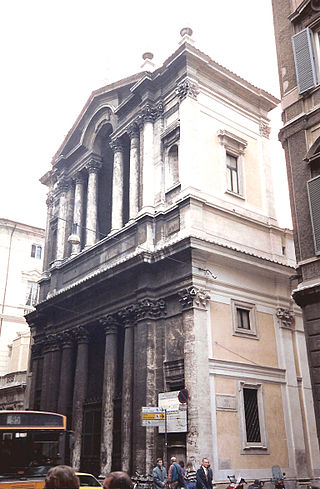
Santa Maria in Via Lata is a church on the Via del Corso, in Rome, Italy. It stands diagonal from the church of San Marcello al Corso. It is the stational church for Tuesday in the fifth week of lent.

The Basilica of Saint Nicholas of Tolentino is a Roman Catholic church and minor basilica that is part of the Augustinian monastery in the hill-town of Tolentino, province of Macerata, Marche, central Italy. The church is a former cathedral of the Roman Catholic Diocese of Tolentino, suppressed in 1586.

San Francesco della Vigna is a Roman Catholic church in the Sestiere of Castello in Venice, northern Italy.

Italian Gothic has characteristics that distinguish it considerably from that of the place of origin of Gothic architecture, namely France, and from other European countries in which this language has spread.
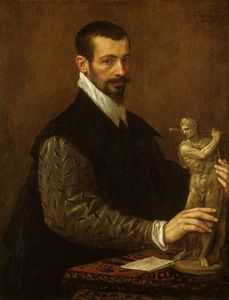
Tiziano Aspetti (1559–1606) was an Italian sculptor of the Renaissance. He was born in Padua and active mainly there and in Venice. He completed both large and small sculpture in bronze. Among his large works are bronze statues in the façade of San Francesco della Vigna and of Saint Anthony and many other sculptural decorations for the Basilica of Sant'Antonio of Padua.
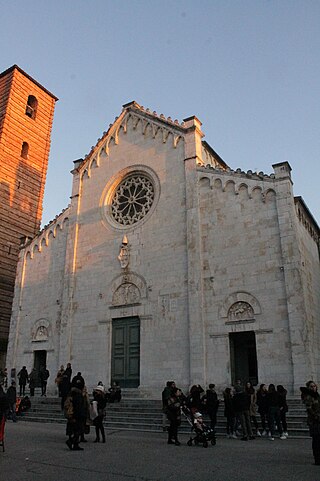
The Collegiate Church of San Martino is a collegiate church in Pietrasanta, in the region of Tuscany, Italy. It is the main church or duomo of the town. It is first mentioned in 1223, and was subsequently enlarged in 1330 and in 1387 when Pope Urban VI had a baptismal font installed in the church.

The Basilica of San Domenico, also known as Basilica Cateriniana, is a basilica church in Siena, Tuscany, Italy, one of the most important in the city. The basilica is an example of Cistercian Gothic style.

Santa Maria dei Carmini, also called Santa Maria del Carmelo and commonly known simply as the Carmini, is a large Roman Catholic church in the sestiere, or neighbourhood, of Dorsoduro in Venice, northern Italy. It nestles against the former Scuola Grande di Santa Maria del Carmelo, also known as the Scuola dei Carmini. This charitable confraternity was officially founded in 1597, and arose from a lay women's charitable association, the Pinzocchere dei Carmini. The members of this lay group were associated as tertiaries to the neighbouring Carmelite monastery. They were responsible for stitching the scapulars for the Carmelites.

The Abbey of Santa Giustina is a 10th-century Benedictine abbey complex located in front of the Prato della Valle in central Padua, region of Veneto, Italy. Adjacent to the former monastery is the basilica church of Santa Giustina, initially built in the 6th century, but whose present form derives from a 17th-century reconstruction.

Volterra Cathedral is a Roman Catholic cathedral in Volterra, Italy, dedicated to the Assumption of the Virgin Mary. It is the seat of the bishop of Volterra.
San Torpé is a Roman Catholic church located in Largo del Parlascio #20 in the town of Pisa, region of Tuscany, Italy.
The Museum of Religious Art' is an art gallery and museum in Certaldo, opened in 2001 and one of the town's three museums.
The Diocesan Museum of Palermo is a museum of religious art in Palermo on Sicily, housed in a number of rooms in the Palazzo Arcivescovile opposite Palermo Cathedral.
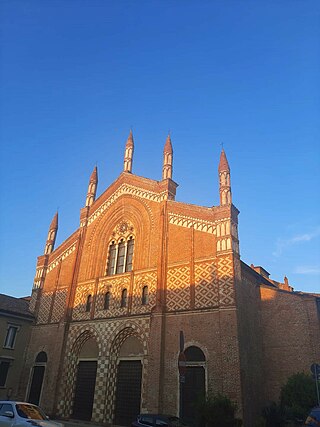
The church of San Francesco of Assisi is a Catholic religious building in Pavia, Lombardy, Italy.


















